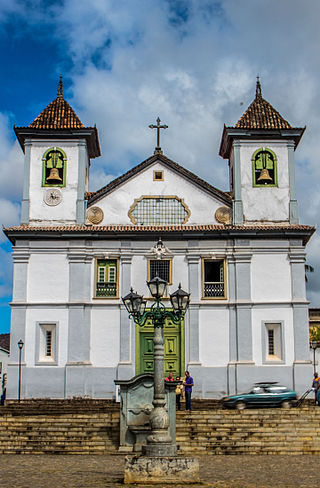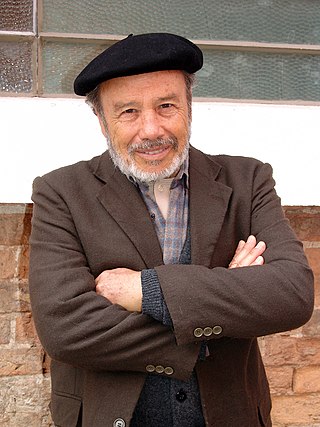
Ouro Preto, formerly Vila Rica, is a Brazilian municipality located in the state of Minas Gerais. The city, a former colonial mining town located in the Serra do Espinhaço mountains, was designated a World Heritage Site by UNESCO due to its Baroque colonial architecture. Ouro Preto used to be the capital of Minas Gerais from 1720 until the foundation of Belo Horizonte in 1897.

Antônio Francisco Lisboa, better known as Aleijadinho, was a sculptor, carver and architect of Colonial Brazil, noted for his works on and in various churches of Brazil. With a style related to Baroque and Rococo, Aleijadinho is considered almost by consensus as the greatest exponent of colonial art in Brazil by Brazilian critics and, surpassing Brazilian borders, for some foreign scholars he is the greatest name of Baroque in the Americas.

Mineiro, Mineirês, or the Brazilian mountain accent is the Brazilian Portuguese term for the accent spoken in the Center, East and Southeast regions of the state of Minas Gerais.

The Roman Catholic Archdiocese of Mariana is an archdiocese based in the city of Mariana in the Brazilian state of Minas Gerais.

The Tietê Bus Terminal is the largest bus terminal in Latin America, and the second largest in the world, after the Port Authority Bus Terminal in New York City. The terminal is located in the Santana district in the city of São Paulo, Brazil. The official name in Portuguese is Terminal Rodoviário Governador Carvalho Pinto, named after Carlos Alberto Alves de Carvalho Pinto, a former Governor of the State of São Paulo.

The Federal Institute of Minas Gerais, or in full: Federal Institute of Education, Science and Technology of Minas Gerais is a polytechnic university or community college located in the Brazilian cities of Belo Horizonte, Bambuí, Congonhas, Formiga, Governador Valadares, Ouro Preto, Ouro Branco, São João Evangelista and João Monlevade.

The Legislative Assembly of Minas Gerais is the state legislature of Brazil's Minas Gerais state. It consists of 77 state deputies elected by proportional representation and is based in Belo Horizonte, the state capital. The Assembly has been based at the Palácio da Inconfidência since the building's 1972 opening; it was made a national heritage site in 2009.

Events from the year 2008 in Brazil.

Events from the year 2013 in Brazil.

Stênio Garcia Faro is a Brazilian actor.

Events from the year 2012 in Brazil.

Events in the year 1896 in Brazil.

Events in the year 1891 in Brazil.

Events in the year 1931 in Brazil.

Events in the year 2015 in Brazil:

Events in the year 2016 in Brazil:
Beatriz Francisca de Assis Brandão was a Neoclassical or Arcadian Brazilian poet, translator, musician, educator and early feminist. One of the few prominent female intellectuals and artists in Brazil during the reign of Pedro II, she became well-known for her poetry, frequently published in Brazilian newspapers. Through her life and work, she challenged the dominant societal roles for women at the time and played an important part in Brazilian social, political and cultural history.

Events in the year 2022 in Brazil.
Idolatrada is a 1983 Brazilian drama film directed by Paulo Augusto Gomes with an original screenplay by him and Mario Alves Coutinho. The film stars Denise Bandeira and Carmen Silva. It is known in English as The Loved One.










